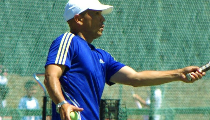Davis Cup Format and Rules
Ties and Rubbers - what it means...
November 14, 2013: Beeyong Sison - In the annual World Group competition, 16 nations compete in 8 first-round ties ("rounds"); the 8 winners compete in 4 quarter-final-round ties; the 4 winners compete in 2 semifinal-round ties; and the 2 winners compete in the final round tie.
Each of the three regional zones is divided into four groups. Groups I and II play elimination rounds, with the losing teams facing relegation to the next-lower group. In Group III and Group IV competition, each tie ("round") consists only of 3 rubbers ("matches"), which include 2 singles and one doubles rubber, which is played in a single day. The rubbers are in the best-of-3-set format, with a tie breaker if necessary to decide all three sets.
As in other cup competitions "tie" is used in the Davis Cup to mean an elimination (or knockout) round, rather than meaning a draw or when competitors' scores are equal. In the Davis Cup, the word "rubber" means an individual match. Thus, "tie" means a round, and "rubber" means a match.
Each tie consists of 5 rubbers ("matches"), which are played in 3 days (usually on Friday, Saturday, and Sunday). The winner of the tie is the nation which wins 3 or more of the 5 rubbers in the tie. On the first day, the first 2 rubbers are singles, which are generally played by each nation's 2 best available singles players.
On the second day, the doubles rubber is played. On the third day, the final 2 rubbers are typically reverse singles, in which the first-day contestants usually play again, but they swap opponents from the first day's singles rubbers. However, in certain circumstances, the team captain may replace one or two of the players who played the singles on Friday by other players who were nominated for the tie.
For example, if the tie has already been decided in favor of one of the teams, it is common for younger or lower-ranked team members to play the remaining dead-rubbers in order for them to gain Davis Cup experience.
Venue and Order of Play
Ties are played at a venue chosen by one of the competing countries. The right of choice is given on an alternating basis. Therefore countries play in the country where the last tie between the teams was not held.
In case the two countries haven't met since 1970, lots are drawn to determine the host country. Prior to each tie, the captain of each nation nominates a squad of four players and decides who will compete in the tie. On the day before play starts, the order of play for the first day is drawn at random.
In the past, teams could substitute final day singles players only in case of injury or illness, verified by a doctor, but current rules permit the captain to designate any player to play the last two singles rubbers, provided that no first day matchup is repeated.
There is no restriction on which of the playing team members may play the doubles rubber: the two singles players, two other players (usually doubles specialists) or a combination. Each rubber is normally played in a best-of-5 set. The first four sets use a tiebreak if necessary, but the fifth set usually has no tiebreaker, so play continues until one side wins by two games (e.g. 10–8).
However, if a team has clinched the tie ("round") before all 5 rubbers ("matches") have been completed, the remaining rubbers may be shortened to the best-of-3-sets, with a tie breaker if necessary to decide all three sets.
Related Articles
World Group Final: Serbia vs Czech Republic Nov 15-17
World Group Semis: Argentina vs Czech Republic Sept 13-15
World Group Semis: Canada vs Serbia Sept 13-15
Word Group Playoff: Spain vs Ukraine Sept13-15
World Group Playoff Japan vs Colombia Sept 13-15
Group II Asia-Oceana Philippines vs New Zealand Sept 13-15
World USA vs Serbia; Czechs vs Kazakhs Apr5-7 Results
World France vs Argentina; CAN vs Italy Apr5-7 Results
Group One SF Aus vs Uzb; Japn vs Kor Apr 5-7 Results
Group II SF Phil vs Thai Apr 5-7 Results
Group II SF Phil vs Thai Preview
World Group Q-finals Apr 5-7. Preview
Results: World Group Feb 1-3. Recap
Results: Group I Asia-Oceana Feb 1-3. Recap
Results: Group II Asia-Oceana Feb 1-3. Recap
Now and Then Article
Davis Cup Past – A Snap Shot Article
Davis Cup Rules: Ties and Rubbers Article
Davis Cup and Tourism in Cebu Article
Davis Cup Finals 2012: Czechs Beat Spain Recap
Davis Cup Hero: Radek Stepanek ITS Blog














